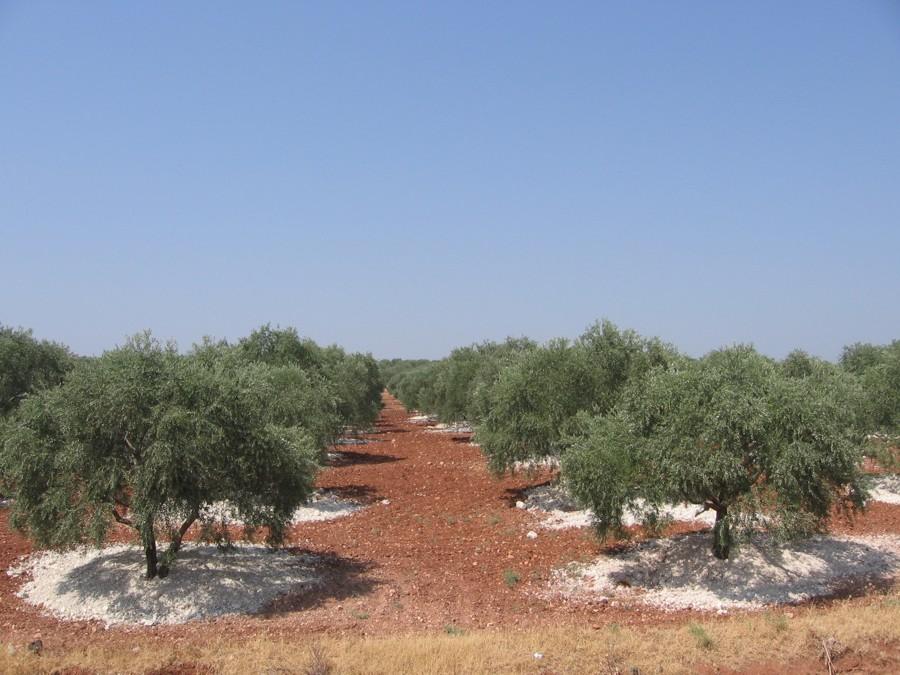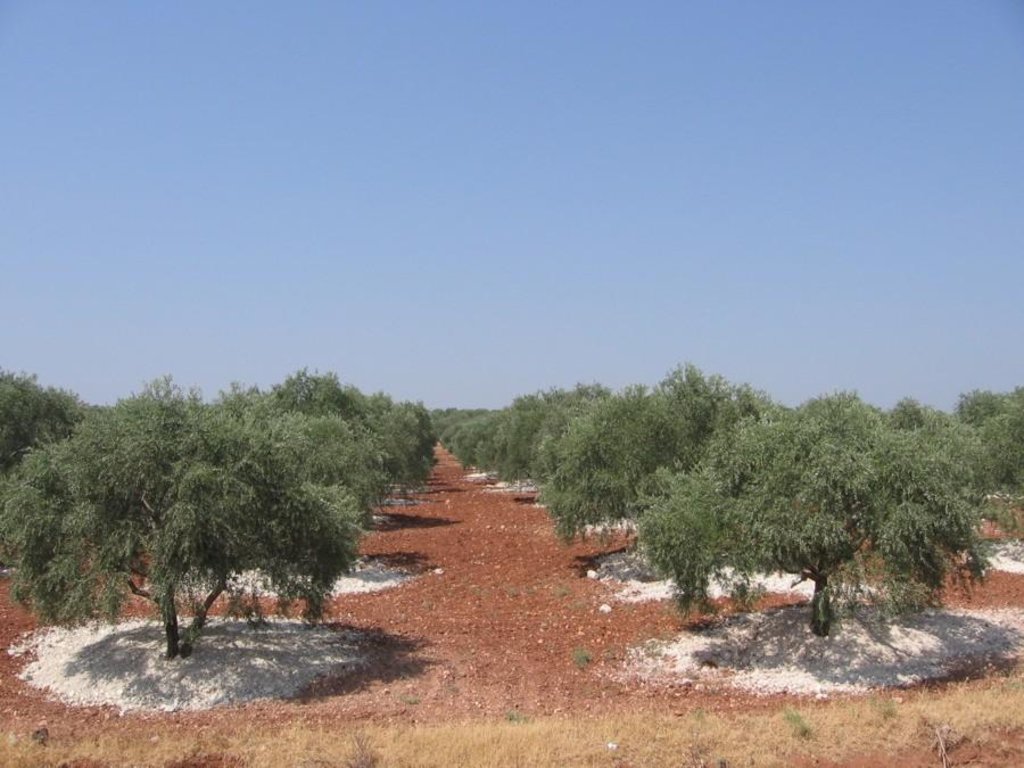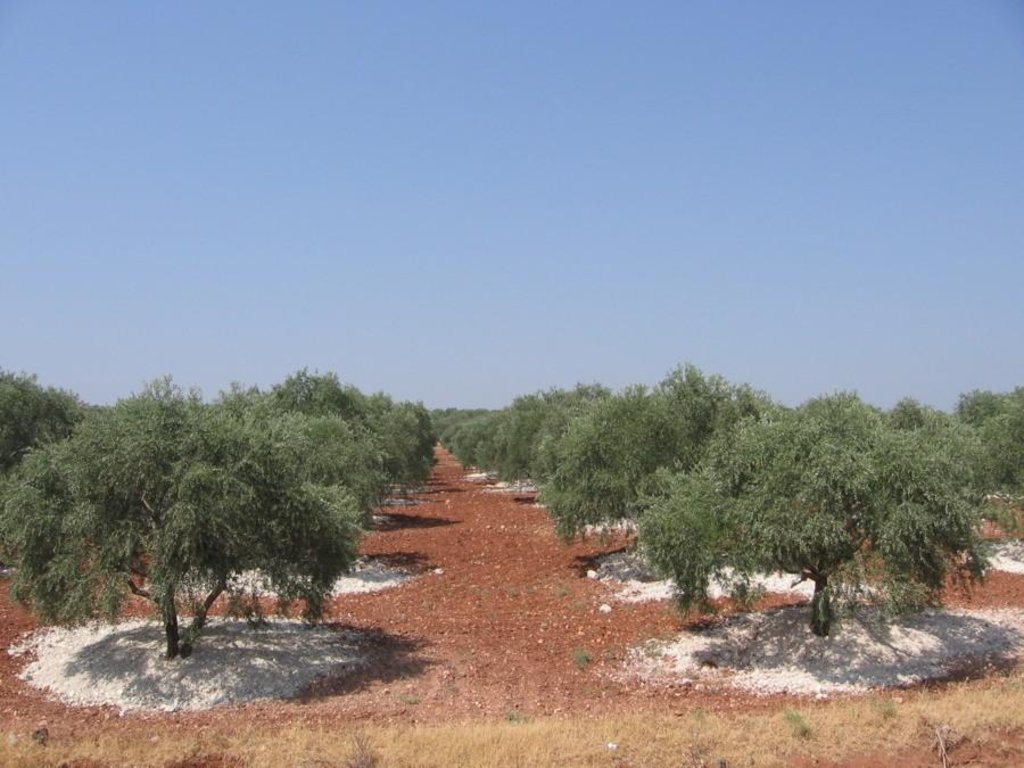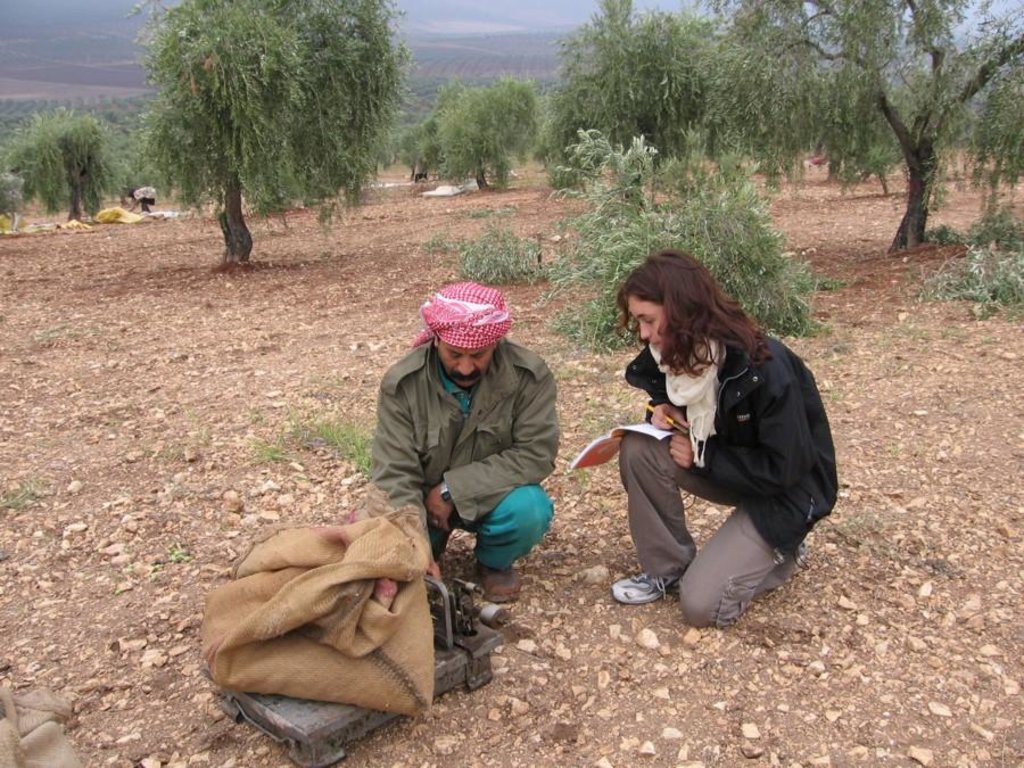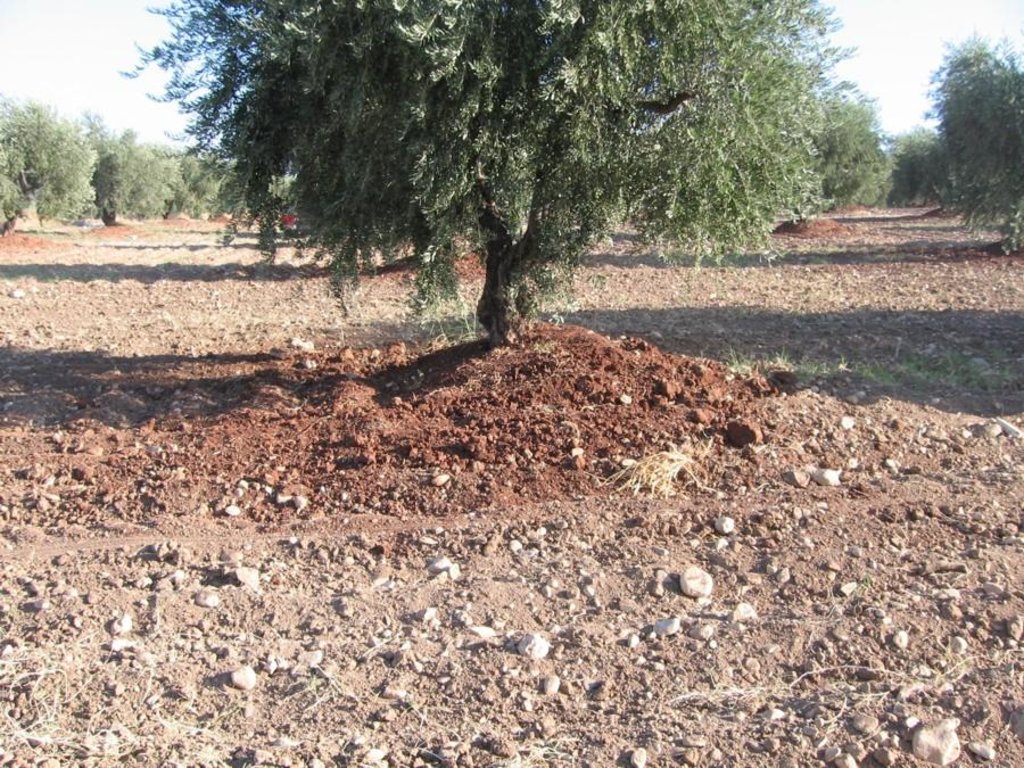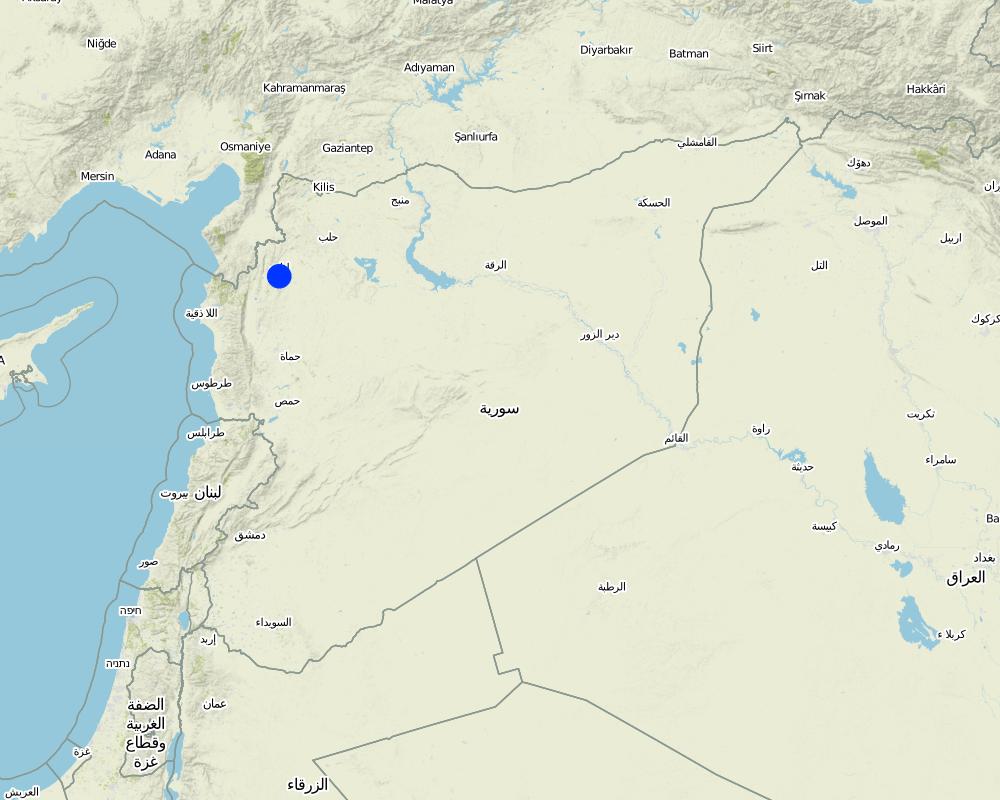Adding soil [Syrie]
- Création :
- Mise à jour :
- Compilateur : Liesbeth Colen
- Rédacteur : –
- Examinateur : David Streiff
approaches_2624 - Syrie
Voir les sections
Développer tout Réduire tout1. Informations générales
1.2 Coordonnées des personnes-ressources et des institutions impliquées dans l'évaluation et la documentation de l'Approche
Spécialiste GDT:
Spécialiste GDT:
Nom du ou des institutions qui ont facilité la documentation/ l'évaluation de l'Approche (si pertinent)
Deutsche Gesellschaft für Internationale Zusammenarbeit (GIZ) GmbH (GIZ) - Allemagne1.3 Conditions relatives à l'utilisation par WOCAT des données documentées
Le compilateur et la(les) personne(s) ressource(s) acceptent les conditions relatives à l'utilisation par WOCAT des données documentées:
Oui
1.4 Références au(x) questionnaire(s) sur les Technologies de GDT
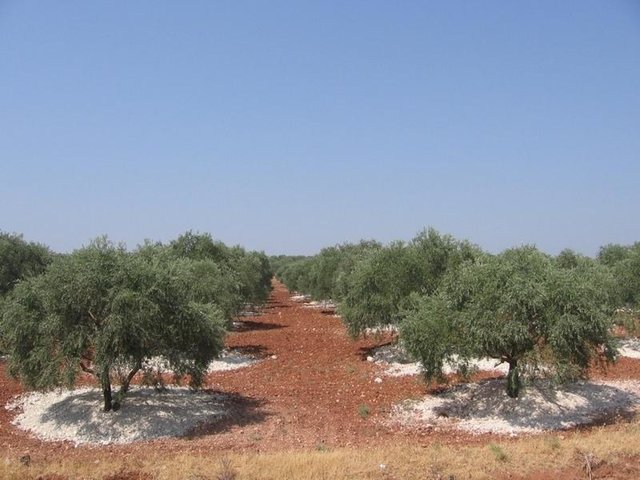
Adding Soil [Syrie]
To add red (fertile, nutrient rich) valley soil to degraded white soil on slopes (in olive orchards)
- Compilateur : Liesbeth Colen
2. Description de l'Approche de GDT
2.2 Description détaillée de l'Approche
Description détaillée de l'Approche:
Aims / objectives: Observation of spontaneously spread analysis. Management invented by farmers themselves, in a later stage it should be adapted or combined with conservation strategies.
Methods: Semi-structured individual interviews and group discussions in the area where the measure is spontaneously adopted.
Stages of implementation: For now only the initial stage: Farmers applying the measure, but to make ita a developed, sustainable and conservation it should be combined with other conservation strategies to make it a complete, sustainable land management strategy,
Role of stakeholders: Technique developed by farmers themselves, they pass information among each other.
Other important information: Can not yet be considered as a real conservation strategy. Till now no interventions from scientists/institutions has been done. Only observation and analysis of this existing land management practice.
2.3 Photos de l'approche
2.5 Pays/ région/ lieux où l'Approche a été appliquée
Pays:
Syrie
Région/ Etat/ Province:
Afrin and Idleb
Map
×2.8 Principaux objectifs de l'Approche
The Approach focused on SLM only
replace top soil which was eroded during rainfalls, increase soil fertility, protect soil from further erosion
2.9 Conditions favorisant ou entravant la mise en œuvre de la(des) Technologie(s) appliquée(s) sous l'Approche
disponibilité/ accès aux ressources et services financiers
- entrave
costly, requires investment
Treatment through the SLM Approach: but applicable at small scale to spread costs over many years.
cadre juridique (régime foncier, droits d'utilisation des terres et de l'eau)
- favorise
The existing land ownership, land use rights / water rights helped a little the approach implementation: In areas without private land ownership farmers have less possibilities (if illegal cultivation on forest land) or incentives (if governmental agricultural land) to change the land by adding soil.
- entrave
Soil is taken away, which is not legal in all cases, lack of clear laws
Treatment through the SLM Approach: need for laws concerning this land management
connaissances sur la GDT, accès aux supports techniques
- entrave
physical environmewnt: can not be implemented on very steep land (tractor cannot reach)
Treatment through the SLM Approach:
3. Participation et rôles des parties prenantes impliquées dans l'Approche
3.1 Parties prenantes impliquées dans l'Approche et rôles
- exploitants locaux des terres / communautés locales
Working land users were mainly men
Only in some exceptional cases farmers' women are interviewed
Decisionmaking done by men, they pass information among each other
Each farmer decides on his own if he wants to try out this technology, economic status only determines the scope (to add soil on onlay a few trees = less expensive, or on all trees = rather done by wealthier farmers)
- Spécialistes de la GDT/ conseillers agricoles
Only in some exceptional cases farmers' women are interviewed.
3.2 Participation des exploitants locaux des terres/ communautés locales aux différentes phases de l'Approche
| Participation des exploitants locaux des terres/ communautés locales | Spécifiez qui était impliqué et décrivez les activités | |
|---|---|---|
| initiation/ motivation | auto-mobilisation | |
| planification | auto-mobilisation | The practice spread spontaneously to neighbouring villages and district |
| mise en œuvre | auto-mobilisation | responsibility for major steps, casual labour; Farmers adopt the practice spontaneously. Some extension officers start advicing the practice |
| suivi/ évaluation | passive | Olive bureau Idleb experimented the addition of white soil on red fields. Recently samples are taken from farmers' fields to analyze the benefits. In the evaluation itself the farmers are not involved, they only agree that soil samples are taken and production is measured. |
| Research | passive | Research od social and economic aspects, farmers are passively involved by interviewing and group discussions. |
3.4 Prises de décision pour la sélection de la Technologie/ des Technologies
Indiquez qui a décidé de la sélection de la Technologie/ des Technologies à mettre en œuvre:
- les exploitants des terres seuls (auto-initiative)
Expliquez:
Decisions on the method of implementing the SLM Technology were made by by land users* alone (self-initiative / bottom-up)
4. Soutien technique, renforcement des capacités et gestion des connaissances
4.1 Renforcement des capacités/ formation
Une formation a-t-elle été dispensée aux exploitants des terres/ autres parties prenantes?
Non
4.2 Service de conseils
Les exploitants des terres ont-ils accès à un service de conseils?
Oui
Décrivez/ commentez:
Advisory service is inadequate to ensure the continuation of land conservation activities; Extension officers will be informed about the lack of sustainability and the need of combination with land management strategies, information/training about the implementation of this conservation strategies however is still lacking
4.3 Renforcement des institutions (développement organisationnel)
Des institutions ont elles été mises en place ou renforcées par le biais de l'Approche?
- non
4.4 Suivi et évaluation
Le suivi et l'évaluation font ils partie de l'Approche? :
Oui
Commentaires:
bio-physical aspects were ad hoc monitored by 0 through measurements; indicators: None
socio-cultural aspects were ad hoc monitored by 0 through observations; indicators: None
economic / production aspects were ad hoc monitored by 0 through observations; indicators: None
area treated aspects were ad hoc monitored by 0 through observations; indicators: None
no. of land users involved aspects were ad hoc monitored by 0 through observations; indicators: None
There were no changes in the Approach as a result of monitoring and evaluation: None
4.5 Recherche
La recherche a-t-elle fait partie intégrante de l’Approche?
Oui
Spécifiez les thèmes:
- sociologie
- économie/ marketing
Donnez plus de détails et indiquez qui a mené ces recherches:
market of soil analysis, social analysis of adopters/innovators/non-adopters
Research was carried out both on station and on-farm
5. Financement et soutien matériel externe
5.1 Budget annuel de la composante GDT de l'Approche
Commentez (par ex. principales sources de financement/ principaux bailleurs de fonds):
Approach costs were met by the following donors: other (farmer himself): 100.0%
5.2 Soutiens financiers/ matériels fournis aux exploitants des terres
Les exploitants des terres ont-ils reçu un soutien financier/ matériel pour la mise en œuvre de la Technologie/ des Technologies?
Non
5.3 Subventions pour des intrants spécifiques (incluant la main d'œuvre)
- aucun
5.4 Crédits
Des crédits ont-ils été alloués à travers l'Approche pour les activités de GDT?
Non
6. Analyses d'impact et conclusions
6.1 Impacts de l'Approche
Est-ce que l'Approche a aidé les exploitants des terres à mettre en œuvre et entretenir les Technologies de GDT?
- Non
- Oui, un peu
- Oui, modérément
- Oui, beaucoup
Few farmers reduced the number of tillage passages to prevent erosion of newly added soil. Untill now only production is affected, but management of soil is still unchanged in most cases.
Est-ce que l'Approche a amélioré les questions foncières et des droits d'utilisation qui entravent la mise en œuvre des Technologies?
- Non
- Oui, un peu
- Oui, modérément
- Oui, beaucoup
The problem is unlikely to be overcome in the near future. Forest land is supposed to stay forest land
Did other land users / projects adopt the Approach?
- Non
- Oui, un peu
- Oui, modérément
- Oui, beaucoup
After being developed in Idleb, farmers adopted the practice in Afrin. The number of farmers adopting the strategy increased exponentially.
6.3 Durabilité des activités de l'Approche
Les exploitants des terres peuvent-ils poursuivre ce qui a été mis en œuvre par le biais de l'Approche (sans soutien extérieur)?
- incertain
Si non ou incertain, spécifiez et commentez:
They can continue the actual practice without support but if the practice needs to be combined with conservation strategies (on the slopes), farmers need support to overcome this investment.
6.4 Points forts/ avantages de l'Approche
| Points forts/ avantages/ possibilités du point de vue de l'exploitant des terres |
|---|
| Results from soil samples can prove the benefit of the practice they 'invented' and give recomendations to improve it. |
| Points forts/ avantages/ possibilités du point de vue du compilateur ou d'une autre personne ressource clé |
|---|
| While observation/analyis has been done the discussion about sustainability is opened |
| Farmers are considered the experts about this technology which might enhance future cooperation |
| Results from soil samples can prove the benefit of the strategy the farmers developed. |
6.5 Faiblesses/ inconvénients de l'Approche et moyens de les surmonter
| Faiblesses/ inconvénients/ risques du point de vue du compilateur ou d'une autre personne ressource clé | Comment peuvent-ils être surmontés? |
|---|---|
| spreading of the practice by the land users did not focus on the sustainability and larger scale | Adaptations should be made and institutions should i ntervene to make this practice sustainable. |
7. Références et liens
7.1 Méthodes/ sources d'information
- visites de terrain, enquêtes sur le terrain
- interviews/entretiens avec les exploitants des terres
7.2 Références des publications disponibles
Titre, auteur, année, ISBN:
Soil transfers in olive orchards of NS Syria, a bio-physical and socio-economic analysisi of a local innovation
Disponible à partir d'où? Coût?
ICD, Bern
Liens et modules
Développer tout Réduire toutLiens

Adding Soil [Syrie]
To add red (fertile, nutrient rich) valley soil to degraded white soil on slopes (in olive orchards)
- Compilateur : Liesbeth Colen
Modules
Aucun module trouvé


